It's here! It's here! It's here!
I am, of course, talking about the region 2 Ghost in the Shell: Stand Alone Complex 2nd GIG boxset, containing another 26 episodes of Ghost in the Shell goodness.
Now, I'm sure I don't need to devote this article to telling you exactly how and why Ghost in the Shell is so good, and I'm certainly not going to spend my time revealing plot spoilers, so the only real thing left to do is discuss it in terms of what came before.
Boxed clever
The 2nd GIG boxset is somewhat more flamboyant than that of the 1st GIG. Whereas the first boxset was somewhat rough and papery, the second season one seems to use smoother paper for the cover, and makes much more use of laminate coating to highlight key elements. The first boxset limited the laminate to the "Ghost in the Shell" text on the front and side, whereas this time it's used for all the text on the front and the side, as well as the frame grabs on the back, and the image of the Major on the front (The other members of Section 9 aren't laminated, however). The image on the front is of course another difference. The first season boxset had a large wraparound image that covered all sides of the box, depicting the Major, a Tachikoma, and Batou. Although the second season boxset does also have a wraparound image, the only interesting part is on the front, with the crowd of Section 9 members - who appear to be obsessed with something to their left. Possibly the 12 foot tall Major who's on the front of the 1st gig boxset sat next to them.
Oh, sorry. You were interested in what's inside the box, weren't you?
DVD menus
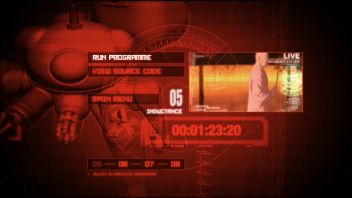 The menus for the 2nd GIG DVDs are somewhat different in style to those for the 1st GIG. It still uses the theme of electrical tracks on circuit boards, but with a much simpler style, akin to the menus for the DVD of the first film. Depending on which DVD you're watching, the menus will be green-on-black, red-on-black, or blue-on-black. Unfortunately some colours work better than others, with the red-on-black style being the hardest to see. It's not that it's a bad style to use, but they've deliberately made some of the text fuzzy, to the point where it can actually be very difficult to see what it says. Maybe it's easier to make out on a proper TV than a TFT computer monitor.
The menus for the 2nd GIG DVDs are somewhat different in style to those for the 1st GIG. It still uses the theme of electrical tracks on circuit boards, but with a much simpler style, akin to the menus for the DVD of the first film. Depending on which DVD you're watching, the menus will be green-on-black, red-on-black, or blue-on-black. Unfortunately some colours work better than others, with the red-on-black style being the hardest to see. It's not that it's a bad style to use, but they've deliberately made some of the text fuzzy, to the point where it can actually be very difficult to see what it says. Maybe it's easier to make out on a proper TV than a TFT computer monitor.
Intro credits
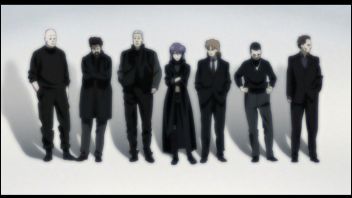 These have also undergone changes. Gone is the dubious CGI sequence, and in its place is a proper animated sequence - much more in keeping with the style and content of the actual episodes. Although it's still essentially a series of disjoint images, this time all the images pull in the same direction - that of highlighting the darker tones of the season. And whereas the first season intro focused on the Major and some Tachikomas, this time all the members of Section 9 make an appearance, looking appropriately moody.
These have also undergone changes. Gone is the dubious CGI sequence, and in its place is a proper animated sequence - much more in keeping with the style and content of the actual episodes. Although it's still essentially a series of disjoint images, this time all the images pull in the same direction - that of highlighting the darker tones of the season. And whereas the first season intro focused on the Major and some Tachikomas, this time all the members of Section 9 make an appearance, looking appropriately moody.
The music has also been redone - it's another song by the multi-lingual Origa, and again focuses on the darker themes of this season.
The content
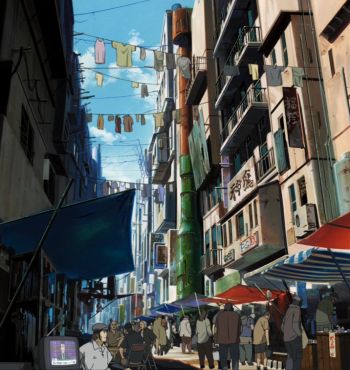 As you can expect, not much has changed with the animation style. However the computer effects seem to have been toned down somewhat - whereas some of the scenes from the first season were rather fuzzy and hard to make out, they seem to have steered away from extreme effects like that this time round. In terms of production quality, the subtitles are also better - many less mistakes and timing issues than for the first season, and a consistent font throughout.
As you can expect, not much has changed with the animation style. However the computer effects seem to have been toned down somewhat - whereas some of the scenes from the first season were rather fuzzy and hard to make out, they seem to have steered away from extreme effects like that this time round. In terms of production quality, the subtitles are also better - many less mistakes and timing issues than for the first season, and a consistent font throughout.
Similar to the animation style, the content of the episodes is also pretty much the same - some detective work, a good deal of tense action scenes, and a lot of wordy bits inbetween, covering subjects such as politics, philosophy, and psychology. The plot and character motivations seem a lot deeper this time round, so you'll need your thinking caps firmly screwed on if you want to be able to follow the reasoning behind everything. Either that, or it's just a load of old tosh - or perhaps attempting to watch the episodes back-to-back with subtitles isn't the best thing to do.
It's not all smoke and mirrors though - some plot points are made very obvious, in particular to do with the actions of the Tachikomas (who, incidentally, have some new abilities this time round.)
The Tachikomas aren't the only things that have changed. This time, the setting for much of the action is in the slums of war-torn refugee cities, making it feel much closer to the grunge of the first film than the high-tech glamour of the first SAC season. The main plotline is also tackling issues on a much grander scale, including assassins targeting the Prime Minister, and the threat of nuclear war. The personalities of some of Section 9's members are also undergoing transformations. In particular the Major is becoming more like the disillusioned person we see in the first film - in fact, the overall structure of the season makes it feel like it's meant to pull everything together into one consistent timeline, although no official statement has been made to that effect. The amount of self-referencing going on (in particular recreations of some of the scenes from the manga) in some ways helps to push this point further, but in other ways it just makes it feel like the franchise is a one-trick pony that must keep regurgitating old parts of itself in order to survive. This, I assume, is unintentional on the part of its creators.
Season breakdown
After finishing watching the season, I became aware that much more time was spent dealing with the main plotline than in the first season. So, I decided to investigate further.
The first season was designed pretty much from the viewpoint that it should be watchable if you've never seen Ghost in the Shell before. This meant that the first 3 episodes were rather simple standalone plotlines, to introduce the viewer to the characters and the themes of the show. But then the next three episodes are dedicated to launching the main plot line, that of the investigation into the Laughing Man. It then goes a bit quiet again, alternating between standalone and complex episodes. In particular there's one large gap from episodes 12 to 19 which is nothing but standalone episodes - making you think that they may have forgotten about the main storyline entirely. However, from episode 20 onwards, it's full-on action as the team find the crucial evidence they require, begin closing the net, and are pushed to their limits as the masterminds behind the crimes realise their fate. In total, 12 of the 26 episodes deal with the main plotline.
The second season is somewhat different in structure. Although they're using a more complex episode classification scheme (which I only fully understood after reading about it on Wikipedia), in reality this classification doesn't matter much because there are so many more episodes devoted to the main plotline - around 18 of them. Although the viewer won't know it yet, the main plotline is introduced in the first episode. Things then go off on a tangent for a few episodes, before returning to the main plotline in episode 5 - at which point it becomes clear that the criminals in the first episode are going to be causing trouble throughout the rest of the season. The following episodes continue to deal with the main plotline, with the flow only stopping a couple of times for some standalone episodes. The standalone episodes this time mainly deal with the histories of some of Section 9's characters, and of the world they inhabit. The action gradually builds up as we move through the season, until episode 21, when it becomes well and truly clear that the season has reached its endgame. This gives the show a 7 episode endgame (from episodes 20 to 26), which makes the 2 episode endgame of the first season pale in comparison.
The outro
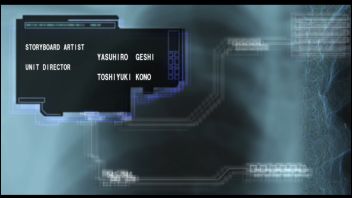 As if you haven't guessed, the outro credits have also gone through a redesign. Whereas the first season had a sequence of still images with the credits roling alongside, the second season goes for a more complex approach, in keeping with the "circuitboard tracks" style. Circuit-style boxes popup onscreen containing the credits, while similar circuit-style images and x-rays cycle in the background - presumably to fit in with the cybernetic themes of the show. The theme of the new credits also fits in with the new music, "Living Inside The Shell", which has full-English lyrics, the same as with the first season.
As if you haven't guessed, the outro credits have also gone through a redesign. Whereas the first season had a sequence of still images with the credits roling alongside, the second season goes for a more complex approach, in keeping with the "circuitboard tracks" style. Circuit-style boxes popup onscreen containing the credits, while similar circuit-style images and x-rays cycle in the background - presumably to fit in with the cybernetic themes of the show. The theme of the new credits also fits in with the new music, "Living Inside The Shell", which has full-English lyrics, the same as with the first season.
Also, by looking at the details on Wikipedia, it's clear that they're using the original Japanese intro and outro credits for this DVD release, as opposed to the reworked intro and outro sequences used in the Japanese terrestrial broadcasts (although obviously with English text instead of Japanese.)
Tachikomatic Days
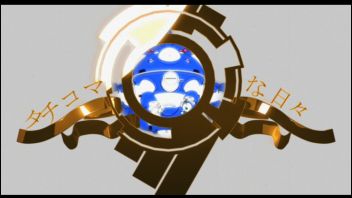 What would Ghost in the Shell be without Tachikomatic Days? Well, about a minute shorter per episode, for a start.
What would Ghost in the Shell be without Tachikomatic Days? Well, about a minute shorter per episode, for a start.
But more seriously, it's nice to see Tachikmaotic Days back again, if only for the new intro sequence (a parody of MGM's roaring lion, and in some instances, a parody of the Universal Studios logo). They've also got a new outro sequence, a parody of Dig Dug. The actual content of the shorts is pretty much the same, however. For me, sometimes the comedy works, sometimes it doesn't. However, the shorts are perhaps more welcome this time round, as they do a good job of lightening the tone after having watched the dark content of the episodes.
Until we meet again...
Well, that's the 2nd GIG over with. Although no official announcement about a 3rd GIG has been made, I do know that the American DVD release of the Stand Alone Complex movie will be in July this year - so presumably the Region 2 release won't be far behind. Expect another article about it when I get my hands on a copy.
What about the conclusion?
Oh, sorry.
If you like sci-fi such as Bladerunner, The Matrix, etc., then you are an idiot if you do not consider watching Ghost in the Shell.
The boxset costs about £30. You get 10 hours of top-notch episodes, along with around 3 hours of cast and crew interviews (at a guess - in my haste to watch the series, I haven't actually watched any of the extras). The season 1 boxset is also available for around the same price, offering the same number of features. The two non-SAC films are of course still available, at appropriate prices.
That is all.
(Although, I am still looking for someone to tell me how to layout images properly. Preferably without spending all day doing it.)
About this entry
- By Jeffrey Lee
- Posted on Saturday, March 03 2007 @ 2:58 pm
- Categorised in TV
- 0 comments
